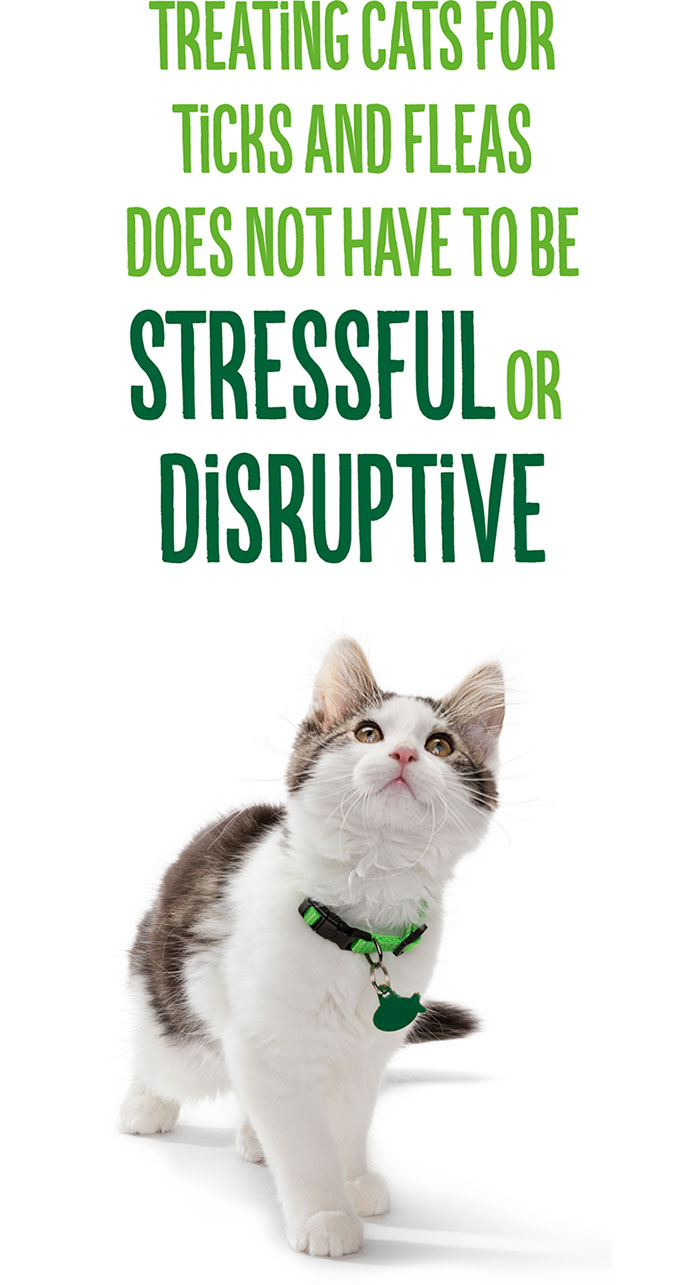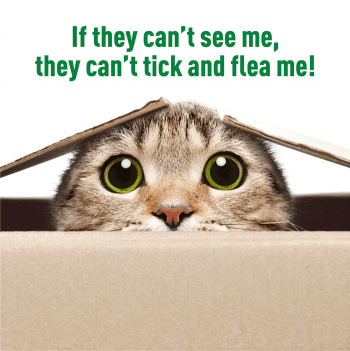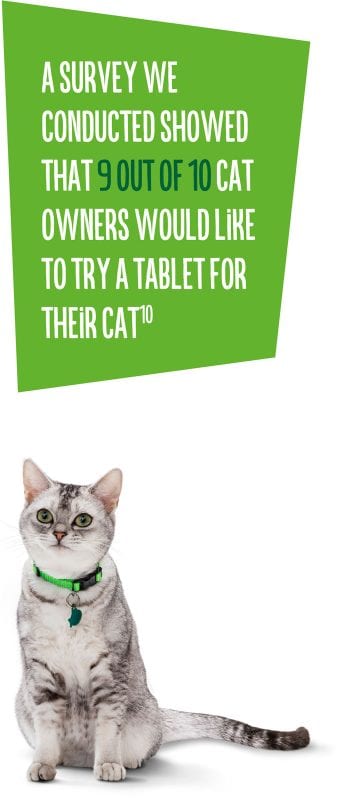4 Feb 2021
The keys to winning the war against ticks and fleas in cats.


Treat regularly, control ticks and fleas, reduce incidence of skin irritation and dermatitis, help prevent transmission of pathogens from animals to humans and contribute to both animal and human health. Simple isn’t it?

Well, no, because despite the range of effective treatments now available including newer cat-friendly methods of administration e.g. oral tablets we’re still not winning the battle against ticks and fleas in cats.
In a 2017 paper1 Michael Rust, Distinguished Professor of Entomology at the University of California Riverside, cites a number of European surveys on prevalence of ticks and fleas, most notably one that looked at 1,519 cats from seven countries in Europe, and found that 15.5% of the cats brought to veterinary clinics were infested with fleas, with some countries or regions reporting higher infestation levels. In a recent article the prevalence of flea infestations in companion animals in Europe is quoted as being between 10-40%, but the authors note that rates of over 70% have been reported.2
When it comes to ticks, a study in the UK showed that of 1,855 cats inspected between May and October 2016, over six hundred (32%) were reported to have one or more attached ticks – the authors conclude that approximately “6.6% of cats in Great Britain with access to outside the home had ticks in the period between May and October”.3 However, even those cats that don’t roam may be at risk – in one US study4, cats that were reported to rarely or never go outside, were found to harbour ticks, strongly suggesting that they have been carried into the home by dogs or people5. This underlines that all cats, including those that spend the majority of time indoors, are at risk of tick infestation and can benefit from tick prevention treatment.

In contrast to what we might think and the widespread use of parasiticides, ticks and fleas numbers seem to be on the increase. Climate change, particularly global warming, as well as increased movement of pets and people, impacts both the density and geographical spread of arthropods6 with studies across Europe showing an increasing challenge, abundance and distribution of ticks and fleas.2,7
What is also interesting (and worrying) about infestations is that they are often accompanied by a lack of owner awareness and understanding. In the Bond et al. study 15 years ago8, over half the owners were unaware their pet had a flea infestation, and just over a third of cat owners were “unaware that if their pet had fleas then the large part of the fleas’ life cycle (eggs, larvae and pupae) would be developing in their home environment”. There have been some more recent research and surveys showing that this lack of awareness of ectoparasites persists in many countries8,9, and certainly many veterinary professionals would recognise this low level of awareness amongst cat owners in their practices, even today.
“Effective flea and tick control, whilst forming a routine part of veterinary practice, has never been more important with studies showing rising abundance of both these parasites, and the diseases they cause in animals and humans” says Dr Ian Wright, Guideline Director at the European Scientific Council Companion Animal Parasites (ESCCAP).

There has been continued development of new compounds to tackle ticks and fleas but more importantly, recently there has been increased focus on designing parasiticide treatments specific for cats, which has led to newer, more ‘cat-friendly’ options such as tiny flavoured tablets.
This increased choice of treatments is important because it enables vets to provide a more ‘bespoke’ approach to parasite control that can be tailored to the individual needs and preferences of each cat and cat owner, leading to better compliance and lower disruption of the cat and cat owner bond. Without compliance even the most efficacious product can be ineffective and perceived as a bad performer.
So how do you get your clients to follow your advice and consistently use treatments as prescribed? Dr Ian Wright suggests, in his article in 20187, that products should go beyond the fast elimination of ticks and fleas on the animal (most of the products do a good job at this when used correctly), and take into account convenience, ease-of-administration and affordability, which have a big impact on client compliance.

Ease-of-administration is particularly important when it comes to cats, as they can often be more difficult to give treatments to, as compared to dogs. Cats are independent, strong-minded and fierce creatures, much less prone to seek their owners’ approval and reward, making treatment administration a regular source of stress and disruption for both cats and those around them. As Ian points out “adverse behavioural and physiological reactions by cats to treatment administration can deter owners from treating them if other treatment modalities are then not available.”7
ESCCAP highlights that having a range of different treatment options and administration routes, and discussing these with the client is an important part of maximising compliance.7

“The key concept here is that “no one-size fits all” says Dr Ian Wright. “Every cat-owner relationship is different and so are their routines and preferences. Therefore it’s important to understand how treatment options fit in to pet owners daily lives, to improve compliance and owner satisfaction.”
Every cat owner is more than aware that a cat is not a small dog and that every cat is different and somewhat “special”; a placid senior Persian cat has very different needs and preferences and requires a different approach as compared to a “full power” domestic short hair cat.
Some cats and owners will prefer spot-ons. Some will prefer to use collars or sprays. Others will prefer tablets (a survey we conducted showed that 9 out of 10 cat owners would like to try a tablet for their cat10). It’s important to openly discuss options with clients, including the innovations in treatments that have led to easier to administer treatments with good acceptance rates.1

The adverse psychological reactions mentioned above (cats running away or hiding for example) at tick and flea treatment time, or the need to separate cats from the family or restrict their freedom following treatment in some cases, can negatively impact the cat-owner relationship. The importance of the cat-owner bond has been shown in numerous studies demonstrating benefits to both physical and mental health of humans.12 Anything that potentially disrupts this bond is likely to demotivate treatment administration and lead to poor compliance.
This underlines the need to consider this aspect, on top of efficacy and convenience when selecting a treatment, to ensure that owners are willing, as well as able to routinely administer. Given that, as humans, we are largely driven by emotions, how a cat reacts to treatment, and an owner feels when administering a treatment are important factors to explore when discussing options – do owners feel bad or guilty? Do they feel, or does their cat seem, stressed? Do they dread tick and flea treatment time? How does the cat feel or display reactions, and what impact does that have on the owner? Research is clear – cat owners want to be able to administer treatment easily, and do not want to feel guilty about upsetting the cat.13-15 Veterinary professionals looking to ensure their cat owners achieve regular and compliant tick and flea treatment, need to take this into account.
Dr Ian Wright explains that “there are many things to take into account when selecting a flea and tick treatment including epidemiological factors, efficacy and other parasite prevention needs. However scientific our approach and elegant our parasite control strategy, it will all count for nothing if the pet owner is unwilling or unable to give the medication we as veterinary professionals have provided.”
For years, a restricted range of options for tick and flea prevention and treatment in cats, was seen as a barrier to effective control. We are now in an era of choice – both for us as vets and for cat owners as consumers. There is a range of efficacious treatments available but ensuring that they are effective means really understanding your cat owner’s world, recommending a treatment that fits conveniently with their individual routines and whose administration is as stress-free and simple as possible.
That will mean different options for different owners, and we – vets, cat owners, the Animal Health Industry – have a duty to explore and overcome potential barriers to compliance, perhaps starting with simply asking cat owners if they have a preference for a tiny tablet for example, so that we can continue to make as big a contribution as possible, to both animal and human health.
Daniela Cavalleri is Principal Research Scientist at Elanco. She is a veterinarian, has a PhD in Biotechnologies Applied to Veterinary and Zootechnical Sciences, as well as an MSc in Pharmaceutical Medicines. She is a speaker at international parasitology conferences (VMX, WAAVP) and has authored over 20 research publications in the area of parasitology and parasiticides, with her most recent research focus being companion animal novel parasiticides.
Elanco and the diagonal bar logo are trademarks of Elanco or its affiliates.
© 2020 Elanco or its affiliates. PM-IE-20-0229. Date of preparation: 08/20.